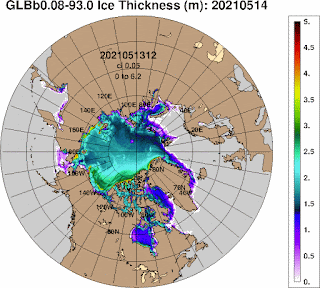 |
| Summer insolation on the Northern Hemisphere in red and in langleys per day (left axis, adapted from Walker, 2008). One langley is 1 cal/cm² (thermochemical calorie per square centimeter), or 41840 J/m² (joules per square meter), or about 11.622 Wh/m² (watt-hours per square meter). In blue is the mean annual sea surface temperature, given as the difference from the temperature over the last 1000 years (right axis, from Bova, 2021). |
While temperatures rose rapidly, especially before the insolation peak was reached, the speed at which temperatures rose was moderated by the snow and ice cover, in a number of ways:
- snow and ice cause sunlight to get reflected back into space
- energy from sunlight is consumed in the process of melting snow and ice, and thawing permafrost
- meltwater from sea ice and runoff from melting glaciers and thawing permafrost cools oceans.
 |
| [ from earlier post ] |
Temperatures could keep rising for many years, for a number of reasons:
- Snow & Ice Cover Loss - A 2016 analysis by Ganapolski et al. suggests that even moderate anthropogenic cumulative carbon dioxide emissions would cause an absence of the snow and ice cover in the next Milankovitch cycle, so there would be no buffer at the next peak in insolation, and temperatures would continue to rise, making the absence of snow and ice a permanent loss.
- Brighter Sun - The sun is now much brighter than it was in the past and keeps getting brighter.
- Methane - Due to the rapid temperature rise, there is also little or no time for methane to get decomposed. Methane levels will skyrocket, due to fires, due to decomposition of dying vegetation and due to releases from thawing of terrestrial permafrost and from the seafloor as hydrates destabilize.
- No sequestration - The rapidity of the rise in greenhouse gases and of the associated temperature rise leaves species little or no time to adapt or move, and leaving no time for sequestration of carbon dioxide by plants and by deposits from other species, nor for formation of methane hydrates at the seafloor of oceans.
- No weathering - The rapidity of the rise also means that weathering doesn't have a chance to make a difference. Rapid heating is dwarfing what weathering can do to reduce carbon dioxide levels.
- Oceans and Ozone Layer Loss - With a 3°C rise, many species including humans will likely go extinct. A 2013 post warned that, with a 4°C rise, Earth will enter a moist-greenhouse scenario. A 2018 study by Strona & Bradshaw indicates that most life on Earth would disappear with a 5°C rise. As temperatures kept rising, the ozone layer would disappear and the oceans would keep evaporating and eventually disappear into space, further removing elements and conditions that are essential to sustain life on Earth.
All this has implications for the interpretation of the Paris Agreement. At the Paris Agreement, politicians pledged to take efforts to ensure that the temperature will not exceed 1.5°C above pre-industrial levels.
So, what is pre-industrial? To calculate how much the temperature has risen, let's start at 2020 and go back one century. According to NASA data, the temperature difference between 1920 and 2020 is 1.29°C (image below).
Of course, 1920 is not pre-industrial. As the IPCC mentions, the 'pre-' in pre-industrial means 'before', implying that 'pre-industrial' refers to levels as they were in times well befóre (as opposed to when) the Industrial Revolution started.
A huge temperature rise by 2026?
A recent post suggests that the 1.5°C threshold was already crossed in 2012, i.e. well before the Paris Agreement was adopted by the U.N. (in 2015), while there could be a temperature rise of more than 3°C by 2026.
 |
| [ from earlier post see CH4 GWP] |
• El Niño events, according to NASA, occur roughly every two to seven years. As temperatures keep rising, ever more frequent strong El Niño events are likely to occur. NOAA anticipates the current La Niña to continue for a while, so it's likely that a strong El Niño will occur between 2023 and 2025.
https://cdnsciencepub.com/doi/10.1139/A08-004
https://www.nature.com/articles/s41586-020-03155-x
• Palaeoclimate puzzle explained by seasonal variation (2021)
https://www.nature.com/articles/d41586-021-00115-x
• Important Climate Change Mystery Solved by Scientists (news release 2021)
https://www.rutgers.edu/news/important-climate-change-mystery-solved-scientists
• Milankovitch (Orbital) Cycles and Their Role in Earth's Climate - by Alan Buis (NASA news, 2020)
https://climate.nasa.gov/news/2948/milankovitch-orbital-cycles-and-their-role-in-earths-climate
• Milankovitch cycles - Wikipedia
https://en.wikipedia.org/wiki/Milankovitch_cycles
• Insolation changes
https://energyeducation.ca/encyclopedia/Insolation
http://www.geo.umass.edu/faculty/bradley/bradley2003x.pdf
• Late Holocene climate: Natural or anthropogenic? - by William Ruddiman et al. (2015)
https://agupubs.onlinelibrary.wiley.com/doi/full/10.1002/2015RG000503
• Critical insolation–CO2 relation for diagnosing past and future glacial inception - by Andrey Ganapolski et al. (2016)
https://www.nature.com/articles/nature16494
• Earth is on the edge of runaway warming
• Paris Agreement
https://unfccc.int/process-and-meetings/the-paris-agreement/the-paris-agreement
https://unfccc.int/sites/default/files/english_paris_agreement.pdf
• IPCC Special Report: Global warming of 1.5 ºC — Box SPM.1: Core Concepts
• IPCC AR5 Synthesis Report — Figure 2.8
https://www.ipcc.ch/report/ar5/syr/synthesis-report
• IPCC AR5 Report, Summary For Policymakers
https://www.ipcc.ch/site/assets/uploads/2018/02/WG1AR5_SPM_FINAL.pdf
• Most Important Message Ever
https://arctic-news.blogspot.com/2019/07/most-important-message-ever.html
• Radiative forcing of carbon dioxide, methane, and nitrous oxide: A significant revision of the methane radiative forcing - by M. Etminan et al.
https://agupubs.onlinelibrary.wiley.com/doi/full/10.1002/2016GL071930
• When Will We Die?
https://arctic-news.blogspot.com/2019/06/when-will-we-die.html
• Possible climate transitions from breakup of stratocumulus decks under greenhouse warming - by Tapio Schneider et al.
https://www.nature.com/articles/s41561-019-0310-1
• A World Without Clouds
https://www.quantamagazine.org/cloud-loss-could-add-8-degrees-to-global-warming-20190225
• How close are we to the temperature tipping point of the terrestrial biosphere? - by Katharyn Duffy et al.
• 2020: Hottest Year On Record
https://arctic-news.blogspot.com/2021/01/2020-hottest-year-on-record.html
• Overshoot or Omnicide?
• Confirm Methane's Importance
https://arctic-news.blogspot.com/2021/03/confirm-methanes-importance.html
• Arctic Ocean invaded by hot, salty water
• Greenhouse gas levels keep rising at accelerating rates
https://arctic-news.blogspot.com/2021/06/greenhouse-gas-levels-keep-rising-at-accelerating-rates.html
https://arctic-news.blogspot.com/p/climateplan.html





































